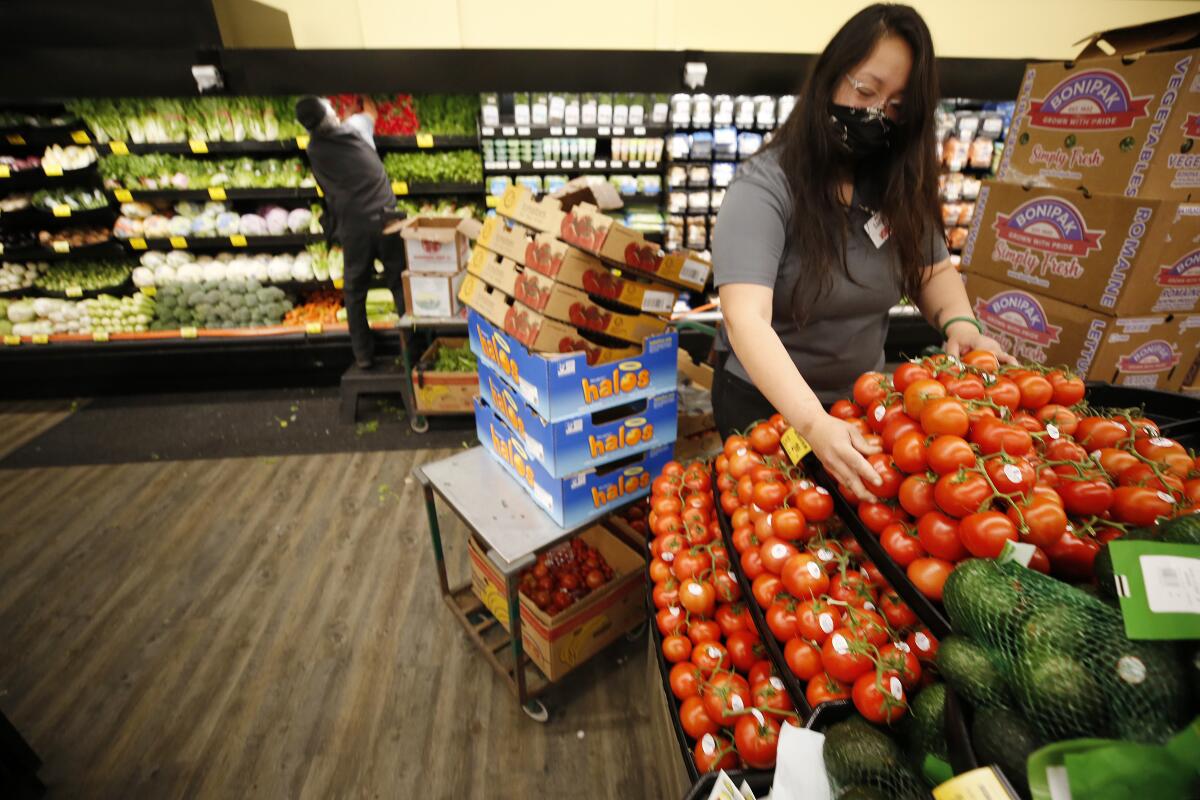California food assistance program hits a ‘crisis point’ in keeping up with demand

- Share via
SACRAMENTO — County offices in charge of administering monthly food benefits to low-income Californians are understaffed and overwhelmed, leading to delays in services as the state stalls a promised boost in funding for the CalFresh assistance program.
Families are experiencing longer wait times for assistance due to prolonged staff vacancies and casework backlogs because of underfunding of administrative costs for the state program, said Kari Beuerman, social services director for Marin County, where income disparities are stark.
The Marin County program maintains a 16%-to-20% staff vacancy rate. Meanwhile, applications for CalFresh services there increased by 70% between 2017 and 2021.
Counties across the state have had to make trade-offs to fill staffing gaps, Beuerman said, with some opting to close hotlines dedicated to fielding questions about assistance so that workers can catch up on enrollment and eligibility paperwork.
“We’re one of the counties that’s considering our options to deal with the backlog,” she said. “We’re really loath to go there, but we have to contend with our [staff] vacancy rate, a high volume of applications and just an inability to get it all done. We’re going to have to make some tough decisions.”
As of December, 4.6 million people in California — nearly 12% of the population — received monthly food benefits from CalFresh, the state’s version of the federal Supplemental Nutrition Assistance Program.
Before the COVID-19 pandemic hit, Gov. Gavin Newsom vowed to increase the CalFresh budget. But the plan was delayed last year, and again in the governor’s budget plan released in January.
The Newsom administration has acknowledged the need to increase the CalFresh funding system, which has not changed in 20 years, but pointed to pandemic disruptions as reason for the delay.
The federal government, which funds food benefits, supplies only half of the administration costs to pay CalFresh staff and keep offices running. The rest is funded by the state and individual counties.
State funding for operational costs covers only about 60% of what counties need, according to a legislative analysis.
Anti-poverty advocates have praised Newsom for expanding public assistance eligibility to more Californians, but county workers say they can’t keep up with increasing demand.
The governor proposed more than $35 million in January to expand food benefits to all Californians older than 55 regardless of immigration status, as immigrants lacking documentation do not qualify for CalFresh. Last year, Newsom signed a law extending CalFresh benefits to eligible college students.
“There have been all kinds of policy changes that have broadened the eligible population for these benefits, which is wonderful, but the funding has not kept pace, which makes it extremely challenging to respond in a timely manner to these requests and have sufficient staffing,” Beuerman said. “We are struggling.”
The County Welfare Directors Assn. of California is asking Newsom to supply an extra $60 million in his budget proposal to address staffing shortages until state officials tackle their broader goal of overhauling the funding formula.
In Fresno County, where 17% of people live in poverty, there are 310 vacancies in the department, amounting to a vacancy rate of about 12%.
Linda Du’Chene, the county’s deputy director for social services, said workers are forced to prioritize tasks related to CalFresh cases over the state’s Medi-Cal program because federal rules require that those who are eligible receive food within 30 days and, in some emergency cases, within three days.
“We don’t have a sufficient enough workforce to divide the programs,” she said. “It may mean delays on the healthcare side, and that’s really unfortunate. It feels like we have to choose food over healthcare, and the clients need both. It really does put the county in a dire position.”
Funding for CalFresh has remained static despite significant changes in the state budget over the years — the formula has not changed since the early 2000s, when the state ended cost-of-living adjustments as it scrambled to make cuts in light of a recession. But the state is now flush with cash and has a record budget surplus.
The economic toll of the pandemic sparked a record surge in CalFresh applications. In January 2020, an average of 4.1 million Californians received CalFresh benefits. By June 2020, that number rose to 4.8 million.
State funding for counties to administer CalFresh benefits amounted to $804 per household in 2000, and now equals $328 per household, according to Department of Social Services data.
While counties called for more funding before the pandemic, the so-called Great Resignation has compounded the problem as people reevaluate in-person office jobs, making it more challenging to hire and keep workers.
“Professions like social workers and eligibility workers, it’s very, very stressful work in the best of times, but during the pandemic, these jobs have become even harder,” Beuerman said. “We’ve had difficulty recruiting and retaining staff.”
The County Welfare Directors Assn. of California estimates that if the state had provided annual inflation adjustments to its share of administration funding, counties would have received an additional $414 million this year. Combined with required federal and county matching funds, that could mean a shortfall of more than $1 billion, which would cover the salaries of about 6,400 workers, according to the group.
“There really is a human toll. Our members are saying, ‘I’m not providing the service I want to because I don’t have the staff,’” said Cathy Senderling-McDonald, executive director of the association. “It’s hit the crisis point.”
Senderling-McDonald said it’s understandable that the pandemic delayed plans, but that more funding now is crucial.
Tyler Woods, an analyst with Newsom’s Department of Finance, said at a legislative hearing last week that the Newsom administration is “open to discussion” about an additional $60 million to bridge the gap now, and plans to revisit an overhaul of the formula post-pandemic.
“We recognize that there is a need to reevaluate that existing [funding] methodology,” Woods said. “The pandemic limited our ability to go in and reevaluate that.”
More to Read
Sign up for Essential California
The most important California stories and recommendations in your inbox every morning.
You may occasionally receive promotional content from the Los Angeles Times.











